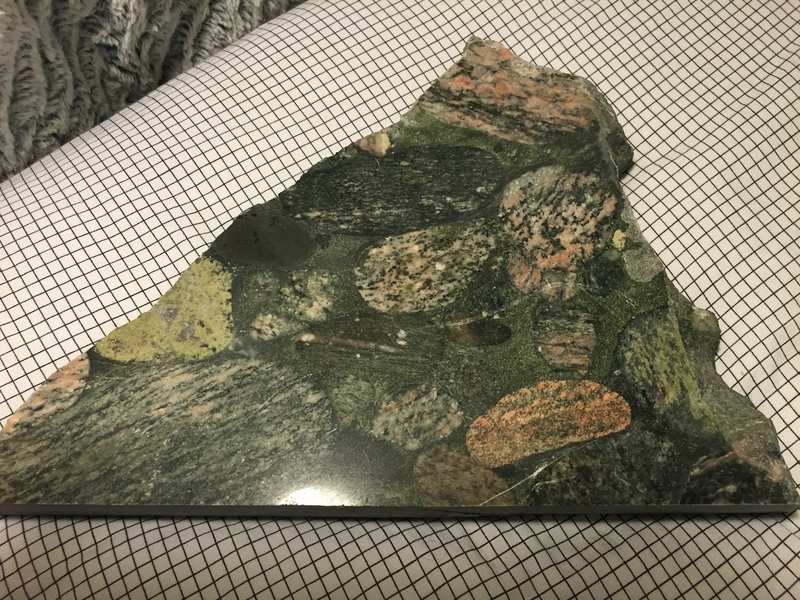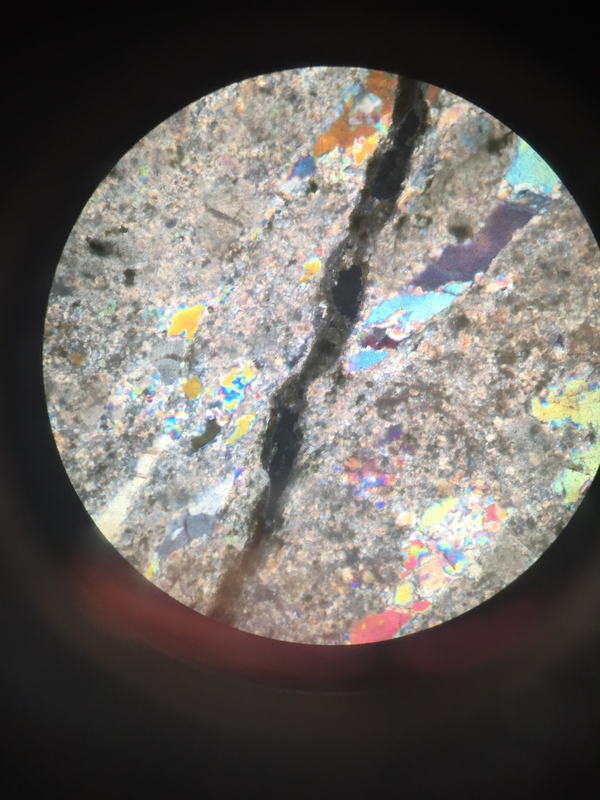2015-CTP-11
Item
-
Title
-
2015-CTP-11
-
Description
-
Meta-Conclomerate
Hand Specimen
Conglomerate protolith that underwent metamorphism
Clasts deformed from initial metamorphism of source rock
-followed by erosion & high energy deposition (given large clast size)
-matrix of sand appears green (Fig. 1)
-cement matrix not as strong as clasts, breaks easier around clasts (Fig. 2)
-clasts appear to be oval shaped which could have been caused by metamorphism deformation
Entire sample metamorphosed
-large clasts in granite have been previously metamorphosed as well
-green matrix/groundmass consists of a dark sand, probably fairly close to a volcanic source
Composition (Hand Specimen)
Entire sample is metamorphosed and composed of about 60% pebble and 40% matrix (Fig. 3)
-large clasts appear to consist of quartz, plagioclase feldspar and pink feldspars)
-interstitial small tiny grains invisible to naked eye appear greenish-black
Though some clasts break around weaker cement, less strong clasts may crack due to pressure during metamorphism, as seen in plain light thin section with light coming through the glass (Fig. 4) and in cross polarization the cracked/split area being black due to glass go slide being isotropic (Fig. 5).
Thin Section (Numbers correlate to Fig. 6)
1) Large clast appears high deformed by metamorphism on slide. (Metamorphosed Twice).
-microscopically appears black and white indicative of plagioclase feldspar microlites under cross polarized light (Fig. 7) with dark brown garnet under XPL and PPL (Fig. 8).
-25x magnification of garnet in PPL seen as a yellowish maroon-brown color (Fig. 9) and under XPL is a black center with dark brown surrounding it (Fig. 10).
-garnet indicates medium to high grade metamorphism after
clast is metamorphosed twice, at the corresponding temperature and pressure (500-650C and 5-7kbars).
2)Clast appears black with large light colored grains within it on thin section. (Metamorphosed Twice).
-Porphyroblast: large crystal in metamorphosed rock that has grown much more than finer grained groundmass.
-PPL shows greenish groundmass suggesting epidote and a light colored euhedral crystal (Fig. 11).
-XPL makes groundmass a darker green and the euhedral crystal to a black-gray alternation due to extinction (Fig. 12).
3) Sandy matrix, appears green, black, and white on thin section, believed to be lithic origin constituting dark material and some larger white grains indicative of quartz and more weather resistant rocks. (Metamorphosed Once).
-Could not further grind slide due to other parts being too thin, but appears to have greenish fine matrix with colorless larger clasts in PPL (Fig. 13).
-In XPL (Fig. 14) matrix turns darker green and larger clasts show birefringence colors (sample still too thick), but, volcanic glass can be seen due to its isotropy (Fig. 15) supporting volcanics among the sandy matrix holding together the larger conglomerate clasts.
4) Large pink/black clast on thin section. (Twice Metamorphosed).
-In plain light there is alternating colorless and gray bands due to foliation caused by the pressure and temperature compressing the rock during metamorphism (Fig. 16).
-In the cross polarized light (Fig. 17) the bands that were colorless in plain light now have a high birefringence (this area of the slight not able to be thinned without sacrificing rest of slide). One grain begins to show twinning (orange/purple grain in lower center of Fig. 17 that shows cross hatching)
Story (Fig. 18)
Two plates colliding and forcing material upwards metamorphoses rock via regional metamorphism.
-large clasts broken off when uplifted and eroded as mountains rise during collision of plates.
-mountains form and become volcanically active from dewatering of subducting plate.
Volcanic rock extruded from volcanic arc along subduction zone—subsequent erosion of volcanics creates small mafic grains that are not very weather resistant.
-lithic sands fill interstitial matrix as erosion and deposition processes bury the alluvial fan in which large, metamorphosed pebble clasts were deposited when the mountains rose.
After volcanics and mountains rise and then come to a period of quiescence, the heavy continental crust of the uplifted mountain range may bow down on the lithosphere, allowing a large amount of deposition on top of the alluvial fan that was previously at a higher elevation and thus receiving less sedimentation from erosional processes.
-weight of added sediment as basin is fills up metamorphoses our conglomerate pebbles a second time (first time for the mafic/lithic sands making up the matrix) forming the sample we found.
-
Creator
-
John Onorati
-
Identifier
-
2015-CTP-11
 https://exhibits.lafayette.edu/geology/files/original/2c4e6025345be88e951b0eb44b0995d5.jpg
https://exhibits.lafayette.edu/geology/files/original/2c4e6025345be88e951b0eb44b0995d5.jpg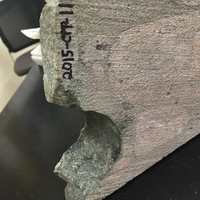 https://exhibits.lafayette.edu/geology/files/original/bef4af2a1c69654f6eea559e013473d4.JPG
https://exhibits.lafayette.edu/geology/files/original/bef4af2a1c69654f6eea559e013473d4.JPG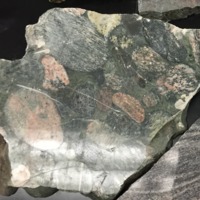 https://exhibits.lafayette.edu/geology/files/original/a6e695280700dee854045e7ed8ad4cd5.png
https://exhibits.lafayette.edu/geology/files/original/a6e695280700dee854045e7ed8ad4cd5.png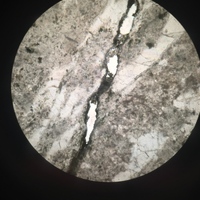 https://exhibits.lafayette.edu/geology/files/original/a34ead929ba5615446018a03fcc1f8ee.jpg
https://exhibits.lafayette.edu/geology/files/original/a34ead929ba5615446018a03fcc1f8ee.jpg https://exhibits.lafayette.edu/geology/files/original/8b259bf7f55e2052b2fdb9488ad998f8.jpg
https://exhibits.lafayette.edu/geology/files/original/8b259bf7f55e2052b2fdb9488ad998f8.jpg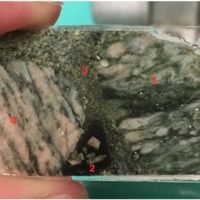 https://exhibits.lafayette.edu/geology/files/original/e3a0a86a46750763997154c60fda65c5.png
https://exhibits.lafayette.edu/geology/files/original/e3a0a86a46750763997154c60fda65c5.png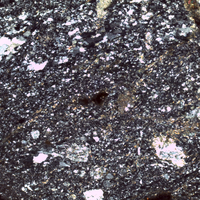 https://exhibits.lafayette.edu/geology/files/original/18dc967a70f5dcccb9913f3d23b7fa4d.jpeg
https://exhibits.lafayette.edu/geology/files/original/18dc967a70f5dcccb9913f3d23b7fa4d.jpeg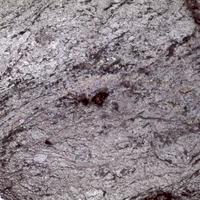 https://exhibits.lafayette.edu/geology/files/original/35e245f8ca434de182b83880e822101c.jpeg
https://exhibits.lafayette.edu/geology/files/original/35e245f8ca434de182b83880e822101c.jpeg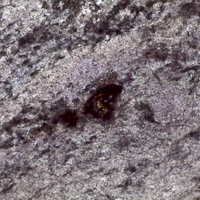 https://exhibits.lafayette.edu/geology/files/original/0de5ba26f7ce6bf1cf40de137f2e5469.jpeg
https://exhibits.lafayette.edu/geology/files/original/0de5ba26f7ce6bf1cf40de137f2e5469.jpeg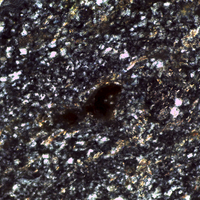 https://exhibits.lafayette.edu/geology/files/original/2e1e6e0a30b42162128bc4cc3ce68aef.jpeg
https://exhibits.lafayette.edu/geology/files/original/2e1e6e0a30b42162128bc4cc3ce68aef.jpeg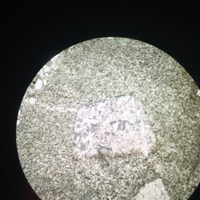 https://exhibits.lafayette.edu/geology/files/original/0049e53b55fc8e62e01a396e017d557e.jpg
https://exhibits.lafayette.edu/geology/files/original/0049e53b55fc8e62e01a396e017d557e.jpg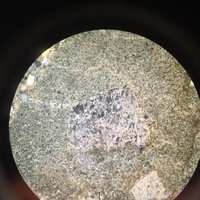 https://exhibits.lafayette.edu/geology/files/original/bcd311ee82971fd54a2c343128f8e14f.jpg
https://exhibits.lafayette.edu/geology/files/original/bcd311ee82971fd54a2c343128f8e14f.jpg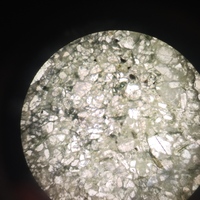 https://exhibits.lafayette.edu/geology/files/original/060921104d70e860bf8816ff98e7679b.jpg
https://exhibits.lafayette.edu/geology/files/original/060921104d70e860bf8816ff98e7679b.jpg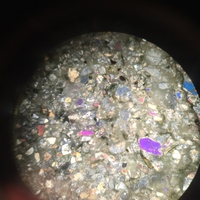 https://exhibits.lafayette.edu/geology/files/original/5720ffdbcc95826da6a26972f4df5b53.jpg
https://exhibits.lafayette.edu/geology/files/original/5720ffdbcc95826da6a26972f4df5b53.jpg https://exhibits.lafayette.edu/geology/files/original/1e6f8a6c33cae361bcd14793720fda09.jpg
https://exhibits.lafayette.edu/geology/files/original/1e6f8a6c33cae361bcd14793720fda09.jpg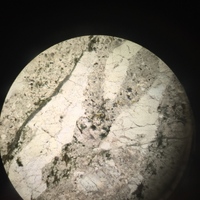 https://exhibits.lafayette.edu/geology/files/original/5f92c6622a903354c76c1cb4f70fc9b5.jpg
https://exhibits.lafayette.edu/geology/files/original/5f92c6622a903354c76c1cb4f70fc9b5.jpg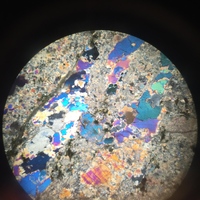 https://exhibits.lafayette.edu/geology/files/original/69bb9c74ded8d8fd3d279926e19dd1c1.jpg
https://exhibits.lafayette.edu/geology/files/original/69bb9c74ded8d8fd3d279926e19dd1c1.jpg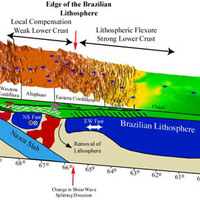 https://exhibits.lafayette.edu/geology/files/original/fd2cdfcc58ac762c84a6afc33300f4d4.jpg
https://exhibits.lafayette.edu/geology/files/original/fd2cdfcc58ac762c84a6afc33300f4d4.jpg